Under the Stairs Dog Houses: Functional Design Ideas
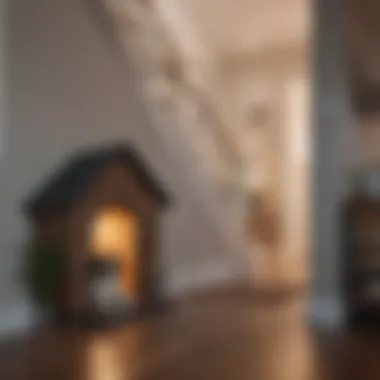
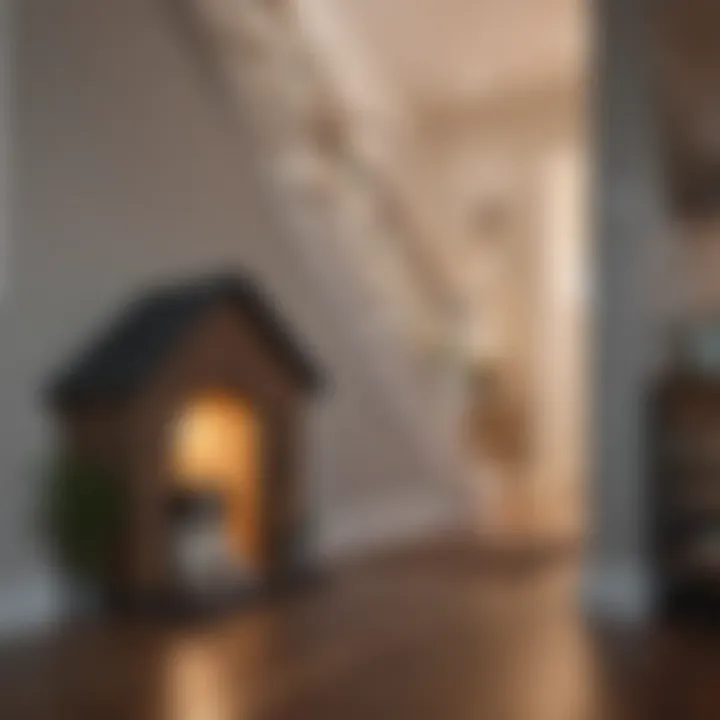
Intro
Creating a dog house that fits under the stairs is not just a trend; it reflects a deeper understanding of space and design. Homeowners increasingly face the challenge of maximizing small areas while ensuring comfort for their pets. The combination of practical design and aesthetic appeal makes this solution particularly interesting. Here, we will delve into the key aspects of under the stairs dog houses, examining their practicality, design choices, and the impact on overall home style.
Key Insights and Trends
As homes evolve, the approach to interior design must also adapt. Under-stairs dog houses exemplify current trends where functionality meets creativity. Rather than being seen as wasted space, the area under stairs can become a cozy haven for pets, beautifully integrated into the living environment.
Current trends in interior design
- Multi-functional Spaces: Many modern homes are designed with flexibility in mind. Areas that serve multiple purposes are gaining popularity. Incorporating a dog house under the stairs is a prime example.
- Sustainable Materials: Eco-friendly materials are trending. Options such as reclaimed wood, bamboo, and non-toxic paints ensure a safe environment for pets while also appealing to environmentally conscious homeowners.
- Custom Designs: Personalization in home decor is on the rise. Custom builds allow pet owners to create unique spaces that match their interior style, whether rustic, contemporary, or minimalist.
"A well-designed dog house under the stairs not only serves a purpose but also enhances the living space aesthetically."
Practical Tips and How-To Guides
For those considering creating an under-stairs dog house, the following steps can guide you through the process:
Step-by-step guide to building an under-stairs dog house
- Measure the Area: Calculate the dimensions of the space under the stairs. Consider your dog’s size to ensure adequate room.
- Choose Materials: Select materials that are safe and easy to clean. Wood, plastic, or even fabric can work well depending on your style.
- Design the Structure: Sketch a simple design. Include features like ventilation or an access door for easy cleaning.
- Build the Dog House: Depending on your skills, either construct it yourself or enlist the help of a carpenter.
- Tailor the Interior: Add bedding, toys, or any comfort items that will make your dog feel at home.
- Final Touches: Paint or decorate it to harmonize with the rest of your home.
Ensuring that the dog house is safe and comfortable is paramount. It's important to test the structure for stability and regularly check for wear and tear.
This comprehensive exploration provides an insight into the practicality and design of under-the-stairs dog houses. Gone are the days where small spaces were dismissed; instead, they are celebrated for their potential in creating unique living arrangements.
Prelude to Under the Stairs Dog Houses
The concept of utilizing space under the stairs for dog houses presents a blend of functionality and innovative design. The growing trend of maximizing every nook in a home is not merely an aesthetic push; it addresses practical needs for pet owners. Homeowners often find it challenging to provide enough room for their dogs, especially in smaller residences. By creating a dog house in underutilized areas like under the stairs, it allows for efficient use of space without sacrificing style.
One major benefit is enhancing your home’s overall utility. Not only does this solution offer a dedicated space for pets, but it also helps maintain order. A tidy environment often correlates with a homeowner’s peace of mind. Each corner of the home can contribute to a better living experience. In addition, dog houses tucked beneath the stairs can blend seamlessly with the home’s decor, making them visually appealing.
Beyond aesthetics, certain considerations must be taken into account. The size and structure of the under-stair area play a crucial role in the design process. Ensuring there is enough height and width for the comfort of the dog is paramount. Furthermore, the choice of materials and ventilation systems is essential to ensure the area remains a cozy retreat for pets.
Ultimately, under the stairs dog houses represent a smart solution for those who wish to reconcile design with the needs of their pets. They embody innovation within practical confines, showcasing how a seemingly wasted space can be transformed into an ideal sanctuary for dogs.
Assessing the Space
Assessing the space available for a dog house under the stairs is critical in ensuring both functionality and comfort for your pet. The area under the stairs often presents unique dimensions that require careful consideration. By properly evaluating this space, you can avoid common pitfalls and ensure that the dog house is not only practical but also a safe haven for your dog. The assessment process involves measuring the area and understanding specific comfort dimensions. These steps are essential for a successful project.
Measuring the Area
Measuring the area under the stairs is the first step in creating a successful dog house. Use a reliable measuring tool, such as a tape measure, to capture the length, width, and height of the available space.
- Square Footage: Calculate the total square footage of the under-stairs area. This number will guide you in determining how much space you can allocate to the dog house.
- Obstacles: Identify any pipes, wires, or other obstacles that might interfere with the installation. Accounting for these in advance can save time later in the process.
- Access Points: Consider how the dog will access the house. Is there enough room for the door? Will your pet fit comfortably in and out of the space? This consideration is crucial to avoid any future issues.
Taking precise measurements will provide a clear blueprint for design and will help in choosing the right materials.
Understanding the Dimensions Required for Comfort
Understanding the dimensions required for dog comfort is also vital. A dog house should be cozy and safe. Consider the following points to ensure your furry friend has a wonderful space:
- Height: Ensure the dog house has enough height so your dog can stand up without bumping their head. This is particularly important for larger breeds.
- Length and Width: The length and width should allow your dog to stretch out comfortably. Generally, add approximately three to six inches to your dog's length for a cozy fit.
- Floor Space: At a minimum, the floor area should match the size of the dog. However, providing additional space for movement is beneficial. Make sure the dog can easily turn around without restriction.
"Creating a harmonious space beneath the stairs enhances both aesthetic appeal and comfort for your pet."
Understanding these measurements before embarking on your project will significantly improve the outcome and avoid frustration. This meticulous approach ensures that the dog house will blend seamlessly into the space, enhancing the overall design of the home while providing a secure refuge for your dog.
Design Considerations
The topic of design considerations is crucial when discussing under the stairs dog houses. These small spaces offer unique opportunities and challenges that must be assessed carefully. Balancing aesthetics with functionality is a primary concern. It is important to create a space that does not just accommodate a pet but also blends seamlessly into the existing interior design. These houses can enhance the overall aesthetic of the home, making them both a refuge for the dog and a visually appealing element for the owners.
Another critical aspect is ensuring that the chosen design meets the needs of the dog. Each breed has unique size and behavior profiles. The design should offer a sense of security and comfort while taking into account the individual preferences of the pet. The layout, entrance size, and internal features should accommodate the dog's breed and personal habits.
Also, there is a significant longevity and durability aspect. The dog house should withstand regular use and potential messes without deteriorating. This leads us to not only consider style but also practicality in maintenance and materials.
"Design is not just what it looks like and feels like. Design is how it works." —Steve Jobs
Aesthetics vs. Function
In the realm of under the stairs dog houses, aesthetics and function often seem at odds. However, the interplay between these elements is what makes a truly successful design. Aesthetically pleasing designs can enhance the room and complement furnishings while ensuring the dog is comfortable and safe. Homeowners should consider styles that will not clash with the surrounding decor.
When comparing aesthetics and function, it is crucial to involve practical elements in the design. For example, a visually appealing door might be fancy but if it restricts the dog’s movement, it fails its function. Clever designs can use materials and colors that match the home while providing necessary features like ventilation and easy access for the dog. Balancing these factors can elevate a project from ordinary to exceptional.
Selecting Appropriate Materials
Choosing the right materials for under the stairs dog houses is vital for both comfort and longevity. Options range from wood, metal, to more advanced composite materials. Durability and safety should be at the forefront when selecting these materials. It is advisable to choose non-toxic finishes since pets often chew or scratch surfaces.
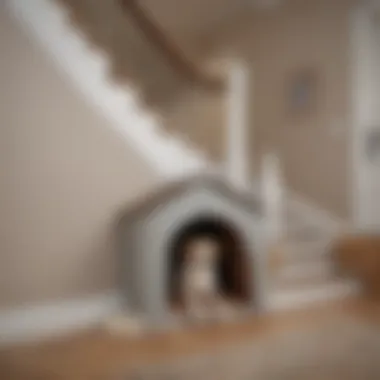
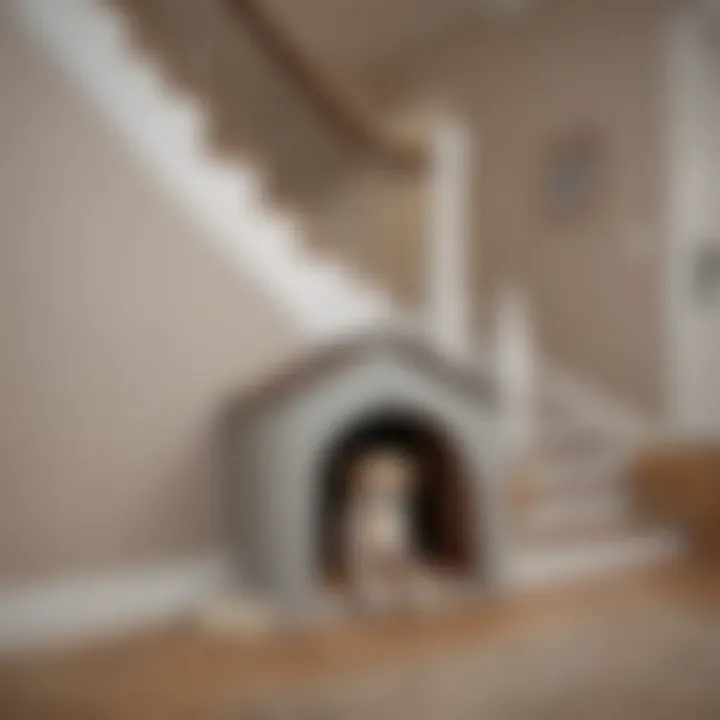
Wood is a popular choice for its aesthetic appeal. Pine or cedar is often selected for their resistance to moisture and pest-related issues. Metal can also be an option, but it should be treated to avoid sharp edges or extreme temperature retention.
Additionally, consideration should be given to ease of cleaning. Materials that can withstand regular washing or have properties to resist stains will ensure the longevity of the dog house. Aspects like insulation for warmth in cold months are also important.
In summary, selection of appropriate materials not only affects the appearance of the dog house but directly impacts its functionality. Knowing how each material interacts with the environment ensures a safe and comfortable home for the pet.
Customization Options
The significance of customization options in under the stairs dog houses should not be underestimated. Customization allows pet owners to create a space that truly meets the specific needs of their dogs while also complementing the broader design aesthetic of their homes. Personalized features can significantly enhance your dog’s experience, encouraging comfort and security within their unique space.
An effective customization process begins with understanding your dog's individual personality and preferences. Factors such as size, breed, and behavior will influence design choices, ensuring the dog house is not only stylish but also functional. The right features can also help reduce anxiety and foster a sense of belonging, making the under the stairs area feel like a true home.
Personalized Features for Your Dog
Incorporating personalized features into an under the stairs dog house can greatly improve your pet's quality of life. Some options include:
- Custom Sizes: Measure your dog and design a house that accommodates both standing and lying positions comfortably.
- Unique Entrances: Tailor the entrance size and shape according to your dog's breed. A larger breed might benefit from a spacious, unobstructed entry, while smaller dogs will appreciate a snug and cozy access point.
- Personalized Décor: Consider adding your dog’s name to the house or using their favorite colors in the design. This adds a unique touch and makes the dog feel recognized.
- Built-in Comforts: Retreats like cushioned beds, blankets, and even relaxing sound machines or toys can create a welcoming atmosphere for your pet.
These features not only enhance physical comfort but also establish a personal touch that can make your dog feel more secure in their environment.
Integration with Home Decor
Aligning the under stairs dog house with your home’s décor is just as essential as its functionality. A well-designed dog house should never stand out annoyingly but rather blend harmoniously with the surrounding space. Here are some ways to achieve that integration:
- Color Schemes: Match the color palette of the dog house with the walls or furniture in the vicinity. This helps create visual cohesion.
- Materials: Use materials consistent with the rest of your home. For instance, if your home features rustic wood, consider stained wood for the dog house as well.
- Design Style: Choose between modern, vintage, or contemporary designs based on your home’s general architecture. A sleek minimalist dog house might suit a modern space, while ornate details could fit a more traditional setting.
- Furniture Placement: Strategically place the dog house in a way that it complements existing furniture rather than crowds the area. A slim design can work well under the stairs while maintaining openness in the room.
Integrating pet spaces into home design emphasizes the importance of pets in our lives while enhancing overall aesthetic value.
By prioritizing both personalization and interior harmony, the under stairs dog house can become a vital part of the home, enhancing both your dog’s comfort and your living space’s beauty.
Safety and Quality Control
In creating dog houses that fit seamlessly under the stairs, the importance of safety and quality control cannot be overstated. Your pet’s health and safety should always be the primary concern when designing a dwelling, no matter how small. Proper safety measures in construction lead to a secure, comfortable, and enjoyable space for your dog. If overlooked, safety issues could result in injuries or stress for your animal. Well-designed dog houses should prioritize both functionality and security, ensuring your beloved companion can rest easily.
When considering safety, pet owners must think about the materials used, their impact on health, and the overall structure’s stability. Each element contributes to a nurturing environment where your dog can thrive. This section will outline specific materials to avoid as well as providing insights into how to ensure that the constructed space is safe and durable for your furry friend.
Materials to Avoid
Choosing the right materials is pivotal when it comes to safety. Certain materials can be harmful or unsuitable for dogs. Here are some types of materials you should avoid:
- Treated Wood: This type of wood often contains toxic chemicals. These substances can be harmful if your dog chews or ingests them.
- Paint with VOCs: Paints that have volatile organic compounds (VOCs) can emit fumes harmful to both humans and pets. Look for paints labeled as low-VOC or VOC-free.
- Certain Fabrics: Avoid fabrics like nylon that can unravel and present choking hazards. Instead, opt for durable and tear-resistant fabrics that are easy to clean, such as polyester or canvas.
- Plastic: Some plastics can emit harmful chemicals, especially when they get hot. Ensure that any plastic used is free from BPA and other toxic substances.
It is essential to scrutinize any materials before installation to guarantee a healthy space for your dog.
Ensuring Stability and Safety
After selecting appropriate materials, it is crucial to ensure that the dog house is stable and secure. Here are some key recommendations:
- Proper Anchoring: When placing the dog house under the stairs, ensure it is anchored securely. This prevents it from tipping over when your pet enters or moves around inside.
- Weight Distribution: The overall weight must be well distributed. A dog house that is top-heavy may become unstable, especially as pets move about.
- Ventilation and Space: Allow adequate space inside for your dog to move around comfortably. Overcrowding can lead to accidents if the dog feels cramped or panicked.
- Regular Inspections: Routine checks every few months can help identify any wear or damage to the structure. Make sure that nothing is loose or breaking down over time.
"A secure dog house not only protects your pet but also prevents damage to your home."
Overall safety and quality control in under-the-stairs dog houses lead to peace of mind for pet owners. Investing time and effort into these aspects guarantees a safe and comfortable haven for your beloved companion.
Dog Comfort Considerations
Focusing on dog comfort is essential when designing under the stairs dog houses. A dog's sense of safety and comfort significantly impacts its overall well-being. By prioritizing comfort, one ensures that the dog has a suitable refuge that caters to its needs and preferences. Comfort does not only address the physical space but also the psychological aspects of how a dog perceives its environment.
Temperature Control and Ventilation
Temperature control and ventilation are critical aspects of maintaining a comfortable environment for dogs. Without proper airflow, the under-stairs area can become too hot or too cold, which is detrimental to a dog’s health.
- Insulation: Insulated walls can help moderate the temperature inside the dog house. Selecting materials like foam can aid in temperature regulation, preventing the habitat from becoming uncomfortably warm during hot seasons or excessively cold in winter.
- Ventilation: Positioning vents or small windows can significantly improve air circulation. Natural airflow contributes to keeping the space fresh and pleasant for the dog. It helps in avoiding condensation and moisture buildup, which can lead to a range of health issues.
A well-ventilated and temperature-regulated environment fosters a more enjoyable retreat for pets, promoting relaxation and better mood.
Creating a Cozy Environment
Creating a cozy environment involves more than merely the physical elements of the house. A dog house must feel secure and inviting to the pet. This can be achieved through different strategies:
- Soft Bedding: Providing soft bedding materials can enhance comfort. Selecting orthopedic beds can serve not just as comfort but as support for older dogs or those with joint issues.
- Places to Snuggle: Incorporating a few blankets might make the space feel homier. Dogs often appreciate having a choice of spots to curl up. Warmth and familiarity can contribute to promoting feelings of safety.
- Personal Touches: Allowing for personalized features like toys or even a space designated for their favorite items can help a dog feel more at home in its new residing space.
Ultimately, the coziness of the dog house can significantly impact how the pet perceives this area. A space that feels inviting encourages a dog to use it willingly, securing its happiness and comfort when staying at home.
Maintenance and Upkeep
The maintenance and upkeep of under the stairs dog houses is fundamental to their functionality and longevity. Careful consideration must be given to cleanliness, safety, and regular checks to ensure that the space remains a cozy haven for dogs. Consistent maintenance not only preserves the structural integrity of the dog house but also enhances the well-being of the pet. Owners must recognize that a well-maintained dog house can prevent health issues, improve comfort, and extend the life of the structure itself.
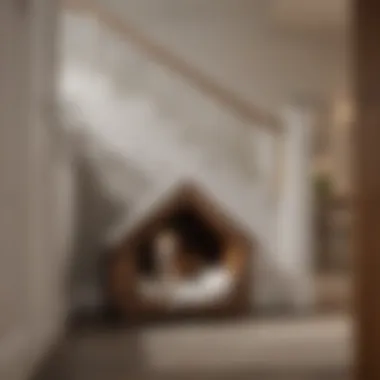
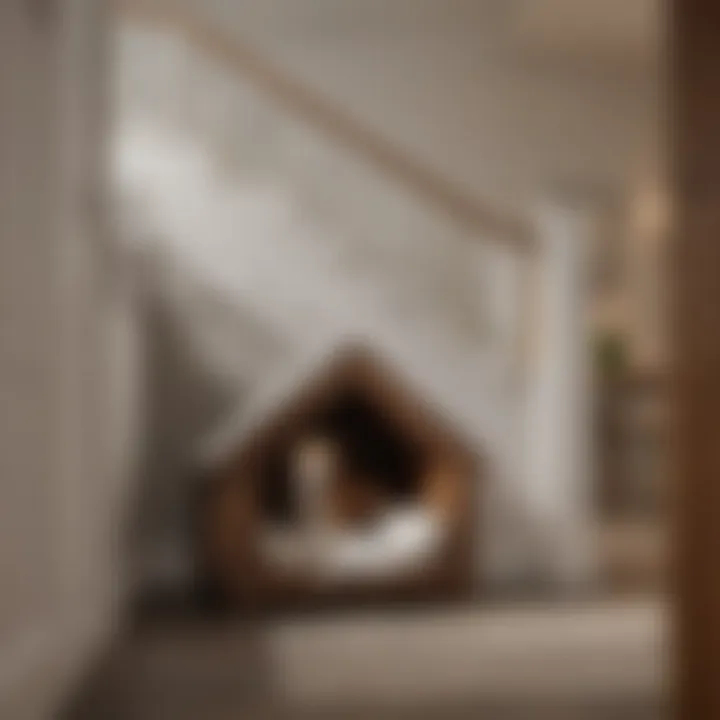
Cleaning and Hygiene Practices
Keeping the dog house clean is vital for the overall health of your pet. Regular cleaning practices help to remove dirt, hair, and potential allergens that may accumulate over time. Here are effective cleaning tips:
- Use Safe Cleaning Products: Choose non-toxic cleaners that are safe for pets to avoid causing any harm. Avoid harsh chemicals that can irritate sensitive noses or skin.
- Spot Cleaning: Perform daily spot cleaning to manage waste and spills. This can help to maintain a pleasant environment for your dog.
- Deep Cleaning: Engage in deeper cleaning sessions weekly. This might involve taking all bedding out, washing it properly, and cleaning surfaces with a damp cloth.
"A clean dog house equates to a healthier dog. Regular maintenance ensures a safe and comfortable space for your pet."
Establishing a schedule for cleaning can greatly improve hygiene. Dogs, like humans, benefit from living in clean conditions that reduce the risk of diseases and discomfort.
Routine Checks for Wear and Tear
Over time, wear and tear are inevitable in any structure, including under the stairs dog houses. Here are some routine checks recommended for maintaining the space:
- Inspect for Structural Integrity: Regularly assess the condition of the dog house. Check for any loose panels, cracks, or weaknesses in the construction. This is crucial to prevent injuries.
- Check Bedding: Ensure that bedding material is intact and free from mold. Discard any old or worn bedding that may hinder comfort or hygiene.
- Look for Signs of Pests: Examine for any signs of infestation by pests such as rodents or insects. Prompt action is key to preventing these issues from escalating.
Maintaining an under the stairs dog house is more than just about keeping it clean. It involves ensuring that the structure is safe and secure, which contributes to the overall happiness and health of your pet. By regularly participating in these maintenance activities, dog owners can create an inviting atmosphere for their beloved pets.
Legal and Regulatory Considerations
Understanding the legal and regulatory considerations is crucial when planning to build under the stairs dog houses. Homeowners must stay informed about local laws and regulations to ensure compliance and avoid potential disputes. This section delves into the essential aspects of these guidelines and how they affect the design process.
One of the main elements to consider is zoning laws. These rules govern property use and dictate what can and cannot be built on residential land. Depending on the locality, certain structures may require permits to ensure they do not infringe on property lines or violate building codes. Before embarking on construction, it is wise to consult local regulations to verify any restrictions that may apply.
Another important aspect to consider is your Homeowner Association (HOA) guidelines. Many communities have established their own set of rules that homeowners must adhere to, especially concerning aesthetics and structural changes.
Homeowner Association Guidelines
Homeowner Association guidelines can greatly influence the design of under-the-stairs dog houses. These rules are typically put in place to maintain a certain aesthetic appeal or uphold community standards. Here are some factors to keep in mind:
- Design Compatibility: Many HOAs require that any structure built conforms with the style of the home and surrounding area. Ensure that the dog house mirrors the architecture of your home to avoid conflicts.
- Size Restrictions: HOAs may also impose limitations on the dimensions of structures. Make sure to confirm that the dog house you intend to create does not exceed these limits, keeping it within acceptable proportions.
- Approval Process: Before starting any construction, you might need to submit plans to your HOA for approval. This process can take time, so factor in a timeline for this step ahead of commencement.
- Maintenance Expectations: Many guidelines also outline obligations regarding upkeep and aesthetic integrity. Plan for ongoing maintenance to adhere to these requirements, which ensures your dog house remains compliant over time.
Each HOA is unique, so meticulous review of their regulations is imperative. Previous cases provide insights into conflicts that arose when owners did not follow guidelines, costing both time and resources. Therefore, taking these considerations seriously can save considerable hassle in the future.
In summary, legal and regulatory considerations play a vital role in ensuring that building an under the stairs dog house is successful. By staying mindful of local regulations, zoning laws, and the specific guidelines set by homeowner associations, pet owners can create functional spaces that benefit both their furry friends and their living environments.
Financial Implications
The concept of constructing dog houses beneath the stairs is intriguing not just for the space-saving benefits but also for financial reasons. By creating an efficient space for your pet, you can save both money and resources. Understanding the various financial implications allows homeowners to make informed decisions while aligning their design choices with their budget. This section examines the costs involved, perceived value, and long-term benefits of tailored under-stairs dog houses.
Cost Analysis of Building Customized Solutions
Creating a custom dog house can be a worthwhile investment. First, consider the upfront costs involved. This includes expenses associated with materials and labor. High-quality materials may carry a higher price tag, but they often ensure durability and reduce the need for frequent repairs. On the other hand, using lower-cost materials may save money initially but could lead to greater expenses down the line due to wear and tear.
Here are crucial factors to assess when analyzing costs:
- Material Costs: The choice of wood, insulation, and flooring will significantly influence the budget. Options such as cedar or treated wood can be more expensive, but their longevity may outweigh initial costs.
- Labor Costs: If someone hires a contractor, labor can be a significant part of the budget. Building the dog house as a DIY project may cut down on expenses, assuming the necessary tools and skills are available.
- Design Complexity: A more intricate design requires additional time and expertise to build, which will increase labor costs. Simple designs tend to be more budget-friendly.
- Customization Features: Features such as ventilation, integrated heating, or personalized dimensions will add to the overall cost. Although these elements enhance functionality, they should be balanced against the budget.
In addition to initial costs, it is essential to consider the potential savings in ongoing expenses. A well-designed dog house can:
- Reduce vet bills by providing a safe and comfortable environment, which can enhance your dog's overall health.
- Conserve energy if the dog house is insulated correctly, making it easier to maintain an ideal temperature.
Moreover, investing in a well-thought-out project can increase the home's overall value. A unique element such as an under-stairs dog house can elevate the aesthetic appeal and functionality of the home, making it more attractive to future buyers.
It is crucial to carry out a thorough cost-benefit analysis, considering both immediate financial impacts and long-term benefits.
"Investing in a well-constructed space caters not just to your pet but adds value to your home as well."
In summary, while the initial costs may seem significant, they have the potential to provide benefits that extend far beyond mere expense. A careful evaluation of these financial implications ensures that you're making sound decisions that align with your budget and your dog's needs.
Case Studies
In practice, these case studies highlight the versatility of under-the-stairs dog houses. Every home is unique; therefore, the way this space is utilized will vary based on architectural elements and personal preferences. Studying diverse homes offers valuable perspectives on the design process and its adaptability.
An important consideration is the homeowner's motivation behind building an under-the-stairs dog house. Often, these installations are driven by the need to maximize space while also providing a comfortable area for the pet. By analyzing different case studies, one can recognize patterns in design elements that resonate with both functionality and taste.
Successful Implementations in Diverse Homes
Exploring specific examples of successful implementations creates a wealth of knowledge. For instance, one case study involved a contemporary urban dwelling where the owners transformed a narrow under-stair void into a stylish dog house. They chose natural wood finishes that complemented their minimalist decor, thus creating a seamless integration with the home's overall aesthetic.
Another instance features a family with multiple dogs living in a more traditional home. They opted for a rustic feel, using reclaimed wood and cozy textiles to enhance the comfort of the space. This not only provided a retreat for their pets but also added a charming design element to their living room.
These case studies illustrate several key benefits:
- Maximized Space: Efficient use of an often neglected area of a home.
- Aesthetic Enhancement: Adding functional decor elements that contribute to the overall design.
- Enhanced Comfort: Custom solutions tailored to the unique needs of different dog breeds.
- Personalization: Each example reflects the homeowner's taste and lifestyle while accommodating their pets.
In summary, case studies demonstrate how effectively designed under the stairs dog houses meet the unique needs of both dogs and owners. They provide evidence that merging aesthetics with functionality is achievable, illustrating various approaches and outcomes that can guide future designs.
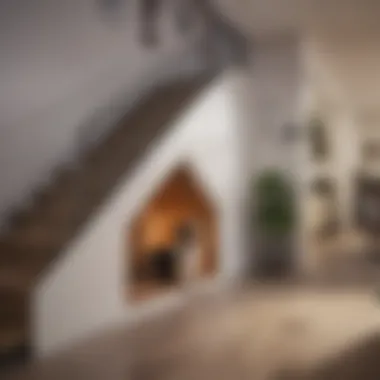
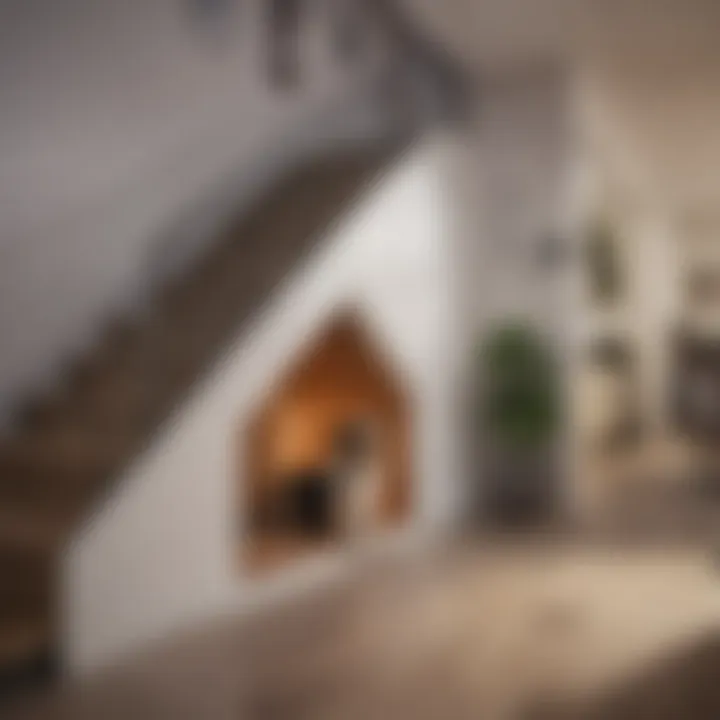
Expert Opinions
In discussions about under the stairs dog houses, the input from experts can significantly shape the quality of design and functionality. Interior designers and pet professionals provide crucial insights that can elevate the basic concept into a more refined solution. Their understanding bridges the gap between aesthetics and practicality, ensuring that the final product not only looks appealing but also serves its intended purpose effectively.
Their expertise often encompasses various elements. Among these, the alignment of the dog house design with the overall architecture of the home is important. A well-integrated design enhances both the living space and the dog's comfort. Moreover, skilled professionals can offer guidance on scaling dimensions to fit specific dog breeds, taking into account growth patterns and comfort needs. This is especially pertinent when it comes to ensuring the dog house remains functional as the pet matures.
The benefits of consulting with these experts also include the ability to anticipate common pitfalls in construction and design. By leveraging their experience, one can avoid issues that may arise from improper materials or inadequate space planning. Consultation can lead to better material selections that enhance durability and safety.
Considering these components, it is clear that expert opinions are an invaluable part of the design process for under the stairs dog houses. They not only lend credibility to the endeavor but also ensure the creation of a space that serves the dog owner’s vision and the dog's well-being.
Insights from Interior Designers and Pet Professionals
Interior designers and pet professionals offer a perspective that combines functionality with style.
- Space Efficiency: They emphasize the importance of maximizing available space. Because under-stairs areas can be awkwardly shaped, interior designers can suggest clever design elements that utilize every inch effectively.
- Safety Protocols: Pet professionals highlight safety as a priority. They can advise on features such as non-slip flooring, rounded edges, and proper ventilation to ensure the dog house is a safe haven for pets.
- Customization for Comfort: Tailoring the design to reflect the unique interests of both the homeowner and the pet is often recommended. This might include incorporating pet-friendly materials, comfortable bedding, and personalized decor.
- Trend Influences: Understanding current trends in home design can affect how an under-stairs dog house fits into the overall aesthetic of a space.
Ultimately, the insights provided by experts turn a standard dog house into something with both style and substance. Leveraging their expertise, pet owners can create environments that cater to their pets’ needs while maintaining the elegance of their living spaces.
Sustainable Practices
In the design and construction of under the stairs dog houses, sustainable practices emerge as a crucial consideration. The rise of eco-conscious consumerism has led homeowners and designers to explore materials and methodologies that have minimal impact on the environment. Sustainable practices not only contribute to environmental sustainability but also enhance the quality and durability of the dog house.
Utilizing sustainable design ensures that the resources employed are responsibly sourced and processed. This includes selecting materials that are non-toxic, renewable, and recyclable. Furthermore, incorporating sustainable practices into dog house design also reflects a commitment to the health of pets and the planet. By choosing eco-friendly solutions, one can create a living space that aligns with broader environmental goals.
Eco-Friendly Materials and Techniques
Choosing eco-friendly materials is central to sustainable practices in building under the stairs dog houses. Common materials that fit this criterion include reclaimed wood, bamboo, and recycled plastics. These materials not only reduce waste but also utilize resources that typically would be discarded.
Additionally, natural finishes, such as non-toxic stains or paints, are recommended to minimize harmful emissions and chemical exposure. Techniques such as natural ventilation can also promote air circulation, enhancing your dog's comfort while maintaining a harmonious environment.
Here are a few eco-friendly materials to consider:
- Reclaimed Wood: Wood that has been salvaged from old buildings or furniture.
- Bamboo: A fast-growing grass, very sustainable and strong.
- Cork: Harvested without harming the tree, it is biodegradable and durable.
- Recycled Plastics: Helps reduce plastic waste in landfills and oceans.
Implementing these materials in the design process contributes significantly to both sustainability and efficiency.
Minimizing Waste During Construction
Waste minimization is another vital aspect of sustainable practices in dog house construction. Achieving this goal begins with thoughtful planning. By recognizing the dimensions of available spaces and the materials needed, builders can significantly reduce excess material.
Constructors can adopt techniques like pre-cutting materials according to specific measurements to avoid scraps. Furthermore, reusing leftover materials from other projects can diminish waste and promote a more sustainable approach.
Strategies for minimizing waste include:
- Planning: Careful measurements lead to less leftover material.
- Use of Templates: Templates can ensure that cuts are precise and reduce errors.
- Smart Sourcing: Buying in bulk can often reduce packaging waste.
Incorporating these strategies not only respects the environment but also results in cost savings.
"Sustainable practices in dog house design represent a commitment to both our pets' comfort and environmental stewardship."
By emphasizing sustainability, homeowners can create meaningful spaces that are beneficial to living beings and the planet, making under the stairs dog houses a paradigm of modern, eco-conscious design.
Innovative Designs
In contemporary home design, the focus has shifted towards optimizing every square inch of available space. Under the stairs dog houses represent a clever application of innovative designs. These tailored spaces cater to the specific needs of pets, enhancing functionality without compromising aesthetic value. A well-designed dog house can reflect the personality of both the homeowner and the pet while remaining practical.
Effective use of under-stair spaces is about blending creativity and practicality, something that is particularly important in modern homes where open floor plans dominate. Here, the space beneath the stairs can be transformed into a cozy retreat for dogs. Thoughtful dimensions and layouts consider both the size of the dog and the overall flow of the living space.
Benefits of Innovative Designs
- Maximized Space Utilization: Designing a dog house under the stairs makes efficient use of often neglected areas. This transformation can reduce clutter and create a sense of order in a home.
- Customization Potential: Innovative designs allow for personal touches that reflect the owner’s style. From colors to textures, the choices are abundant to create a unique environment.
- Improved Aesthetics: A well-implemented design will seamlessly integrate into the existing decor, enhancing the visual appeal of the room rather than detracting from it.
Considerations about Innovative Designs
When embarking on such a project, several considerations must be kept in mind:
- Size and Layout: Before committing to a design, it is essential to measure the space and assess the dog's dimensions. The layout should promote comfort and accessibility for the pet while fitting harmoniously in the existing architecture.
- Temperature Control: The area under a staircase can be prone to temperature fluctuations. Incorporating ventilation solutions and thermal materials becomes essential in innovative designs to maintain a comfortable environment.
- Materials Used: Choosing durable and non-toxic materials is crucial. At the same time, aesthetic choices should not compromise quality or safety for the dog.
"Innovative designs focus on maximizing functionality while maintaining the home's aesthetic balance."
In summary, under the stairs dog houses stand at the intersection of creativity and functionality. They foster a unique solution that benefits both pet and owner, making the most out of underutilized home spaces.
Finale
In today's home design landscape, creativity and practicality are paramount. The concept of under the stairs dog houses embodies this ethos, merging functionality with aesthetic appeal. Space efficiency is no longer just about minimizing clutter; it's about maximizing the potential of every nook and cranny in our homes.
As explored in this article, designing a dog house under the stairs offers numerous benefits. Such designs foster a cozy and sheltered environment for pets while using areas that often remain underutilized. Moreover, these solutions highlight the ingenuity that can be achieved by integrating pet accommodations into broader home decor, achieving harmony in design without compromising the needs of our furry companions.
Final Thoughts on Efficiency in Space Utilization
When considering the efficiency of space utilization, the under the stairs dog house serves as a prime example. Thinking beyond conventional placements for pet beds can lead to innovative use of small areas in your home. This practice reflects a growing trend among homeowners, where the emphasis lies on smarter, rather than larger, living spaces.
The benefits are clear:
- Enhanced comfort for pets in a space that feels secure and private.
- The aesthetic continuity of home design, as these structures can be stylishly integrated.
- Increased organization by reducing clutter in visible areas of the home.



